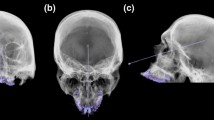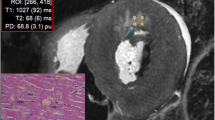Abstract
Recently, post-mortem MR quantification has been introduced to the field of post-mortem magnetic resonance imaging. By usage of a particular MR quantification sequence, T1 and T2 relaxation times and proton density (PD) of tissues and organs can be quantified simultaneously. The aim of the present basic research study was to assess the quantitative T1, T2, and PD values of regular anatomical brain structures for a 1.5T application and to correlate the assessed values with corpse temperatures. In a prospective study, 30 forensic cases were MR-scanned with a quantification sequence prior to autopsy. Body temperature was assessed during MR scans. In synthetically calculated T1, T2, and PD-weighted images, quantitative T1, T2 (both in ms) and PD (in %) values of anatomical structures of cerebrum (Group 1: frontal gray matter, frontal white matter, thalamus, internal capsule, caudate nucleus, putamen, and globus pallidus) and brainstem/cerebellum (Group 2: cerebral crus, substantia nigra, red nucleus, pons, cerebellar hemisphere, and superior cerebellar peduncle) were assessed. The investigated brain structures of cerebrum and brainstem/cerebellum could be characterized and differentiated based on a combination of their quantitative T1, T2, and PD values. MANOVA testing verified significant differences between the investigated anatomical brain structures among each other in Group 1 and Group 2 based on their quantitative values. Temperature dependence was observed mainly for T1 values, which were slightly increasing with rising temperature in the investigated brain structures in both groups. The results provide a base for future computer-aided diagnosis of brain pathologies and lesions in post-mortem magnetic resonance imaging.



Similar content being viewed by others
References
Jackowski C, Warntjes MJ, Kihlberg J, Berge J, Thali MJ, Persson A (2011) Quantitative MRI in isotropic spatial resolution for forensic soft tissue documentation. Why and how? J Forensic Sci 56(1):208–15
Tashiro K, Shiotani S, Kobayashi T, Kaga K, Saito H, Someya S, Miyamoto K, Hayakawa H (2015) Cerebral relaxation times from postmortem MR imaging of adults. Magn Reson Med Sci 14(1):51–6
Zech WD, Schwendener N, Persson A, Warntjes MJ, Jackowski C (2015) Temperature dependence of postmortem MR quantification for soft tissue discrimination. Eur Radiol 25(8):2381–9
Zech WD, Schwendener N, Persson A, Warntjes MJ, Jackowski C (2015) Postmortem MR quantification of the heart for characterization and differentiation of ischaemic myocardial lesions. Eur Radiol 25(7):2067–73
Zech WD, Schwendener N, Persson A, Warntjes MJ, Riva F, Schuster F, Jackowski C (2015) Postmortem quantitative 1.5-T MRI for the differentiation and characterization of serous fluids, blood, CSF, and putrefied CSF. Int J Legal Med 129(5):1127–36
Warntjes JB, Dahlqvist O, Lundberg P (2007) Novel method for rapid, simultaneous T1, T*2, and proton density quantification. Magn Reson Med 57:528–537
Warntjes JB, Leinhard OD, West J, Lundberg P (2008) Rapid magnetic resonance quantification on the brain: optimization for clinical usage. Magn Reson Med 60:320–329
Warntjes MJ, Kihlberg J, Engvall J (2010) Rapid T1 quantification based on 3D phase sensitive inversion recovery. BMC Med Imaging 10:19
Blystad I, Warntjes JB, Smedby O, Landtblom AM, Lundberg P, Larsson EM (2012) Synthetic MRI of the brain in a clinical setting. Acta Radiol 53:1158–1163
Doi K (2007) Computer-aided diagnosis in medical imaging: historical review, current status and future potential. Comput Med Imaging Graph 31(4–5):198–211
Shiraishi J, Li Q, Appelbaum D, Doi K (2011) Computer-aided diagnosis and artificial intelligence in clinical imaging. Semin Nucl Med 41(6):449–62
Birkl C, Langkammer C, Haybaeck J, Ernst C, Stollberger R, Fazekas F, Ropele S (2014) Temperature-induced changes of magnetic resonance relaxation times in the human brain: a postmortem study. Magn Reson Med 71(4):1575–80
Jonkman LE, Soriano AL, Amor S, Barkhof F, van der Valk P, Vrenken H, Geurts JJ (2015) Can MS lesion stages be distinguished with MRI? A postmortem MRI and histopathology study. J Neurol 262(4):1074–80
Egger C, Vaucher P, Doenz F, Palmiere C, Mangin P, Grabherr S (2012) Development and validation of a postmortem radiological alteration index: the RA-Index. Int J Legal Med 126(4):559–66
Synthetic MR products website. Available at: http://www.syntheticmr.com. Accessed September 30th, 2015.
Herrmann K, Johansen ML, Craig SE, Vincent J, Howell M, Gao Y, Lu L, Erokwu B, Agnes RS, Lu ZR, Pokorski JK, Basilion J, Gulani V, Griswold M, Flask C, Brady-Kalnay SM (2015) Molecular imaging of tumors using a quantitative T1 mapping technique via magnetic resonance imaging. Diagnostics (Basel) 5(3):318–332
Gracien RM, Reitz SC, Hof SM, Fleischer V, Zimmermann H, Droby A, Steinmetz H, Zipp F, Deichmann R, Klein JC (2015) Changes and variability of proton density and T1 relaxation times in early multiple sclerosis: MRI markers of neuronal damage in the cerebral cortex. Eur Radiol. 2015 Oct 22
Lundström C, Persson A, Ross S, Ljung P, Lindholm S, Gyllensvärd F, Ynnerman A (2012) State-of-the-art of visualization in post-mortem imaging. APMIS 120(4):316–326
Vågberg M, Lindqvist T, Ambarki K, Warntjes JB, Sundström P, Birgander R, Svenningsson A (2013) Automated determination of brain parenchymal fraction in multiple sclerosis. AJNR Am J Neuroradiol 34(3):498–504
Wu Y, Yang R, Jia S, Li Z, Zhou Z, Lou T (2014) Computer-aided diagnosis of early knee osteoarthritis based on MRI T2 mapping. Biomed Mater Eng 24(6):3379–88
Giannini V, Mazzetti S, Vignati A, Russo F, Bollito E, Porpiglia F, Stasi M, Regge D (2015) A fully automatic computer aided diagnosis system for peripheral zone prostate cancer detection using multi-parametric magnetic resonance imaging. Comput Med Imaging Graph
Gallego-Ortiz C, Martel AL (2015) Improving the accuracy of computer-aided diagnosis for breast MR imaging by differentiating between mass and nonmass lesions. Radiology
Ruder TD, Thali MJ, Hatch GM (2014) Essentials of forensic post-mortem MR imaging in adults. Br J Radiol 87(1036):20130567
Schmidt TM, Fischer R, Acar S, Lorenzen M, Heinemann A, Wedegärtner U, Adam G, Yamamura J (2012) DWI of the brain: postmortal DWI of the brain in comparison with in vivo data. Forensic Sci Int 220(1–3):180–3
Yen K, Lövblad KO, Scheurer E, Ozdoba C, Thali MJ, Aghayev E, Jackowski C, Anon J, Frickey N, Zwygart K, Weis J, Dirnhofer R (2007) Post-mortem forensic neuroimaging: correlation of MSCT and MRI findings with autopsy results. Forensic Sci Int 173(1):21–35
Flach PM, Schroth S, Schweitzer W, Ampanozi G, Slotboom J, Kiefer C, Germerott T, Thali MJ, El-Koussy M (2015) Deep into the fibers! Postmortem diffusion tensor imaging in forensic radiology. Am J Forensic Med Pathol 36(3):153–61
Scheurer E, Lovblad KO, Kreis R, Maier SE, Boesch C, Dirnhofer R, Yen K (2011) Forensic application of postmortem diffusion-weighted and diffusion tensor MR imaging of the of the human brain in situ. AJNR Am J Neuroradiol 32(8):1518–24
Añon J, Remonda L, Spreng A, Scheurer E, Schroth G, Boesch C, Thali M, Dirnhofer R, Yen K (2008) Traumatic extra-axial hemorrhage: correlation of postmortem MSCT, MRI, and forensic-pathological findings. J Magn Reson Imaging 28(4):823–36
Aghayev E, Yen K, Sonnenschein M, Ozdoba C, Thali M, Jackowski C, Dirnhofer R (2004) Virtopsy post-mortem multi-slice computed tomography (MSCT) and magnetic resonance imaging (MRI) demonstrating descending tonsillar herniation: comparison to clinical studies. Neuroradiology 46(7):559–64
Ruder TD, Hatch GM, Siegenthaler L, Ampanozi G, Mathier S, Thali MJ, Weber OM (2012) The influence of body temperature on image contrast in post mortem MRI. Eur J Radiol 81:1366–1370
Dickinson RJ, Hall AS, Hind AJ, Young IR (1986) Measurement of changes in tissue temperature using MR imaging. J Comput Assist Tomogr 10:468–472
Hausmann R, Vogel C, Seidl S, Betz P (2006) Value of morphological parameters for grading of brain swelling. Int J Legal Med 120(4):219–25
Yates A, Thelmo W, Pappius HM (1975) Postmortem changes in the chemistry and histology of normal and edematous brains. Am J Pathol 79(3):555–564
Dettmeyer RB (2011) Forensic neuropathology. In: Dettmeyer RB (ed) Forensic histopathology. Springer, Berlin, pp 413–438
Oehmichen M, Auer RN, Koenig HG (2009) Cell and tissue reactions. In: Forensic neuropathology and associated neurology. Springer, Berlin, pp 42–76
Acknowledgments
We would like to express our gratitude to our team of forensic pathologists and forensic technicians for their support with case handling.
Author information
Authors and Affiliations
Corresponding author
Rights and permissions
About this article
Cite this article
Zech, WD., Hottinger, AL., Schwendener, N. et al. Post-mortem 1.5T MR quantification of regular anatomical brain structures. Int J Legal Med 130, 1071–1080 (2016). https://doi.org/10.1007/s00414-016-1318-3
Received:
Accepted:
Published:
Issue Date:
DOI: https://doi.org/10.1007/s00414-016-1318-3




